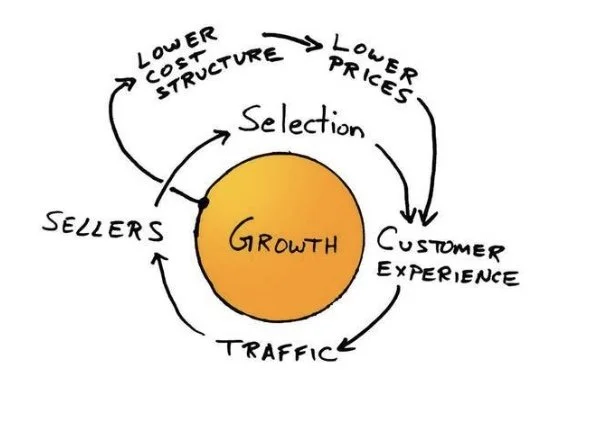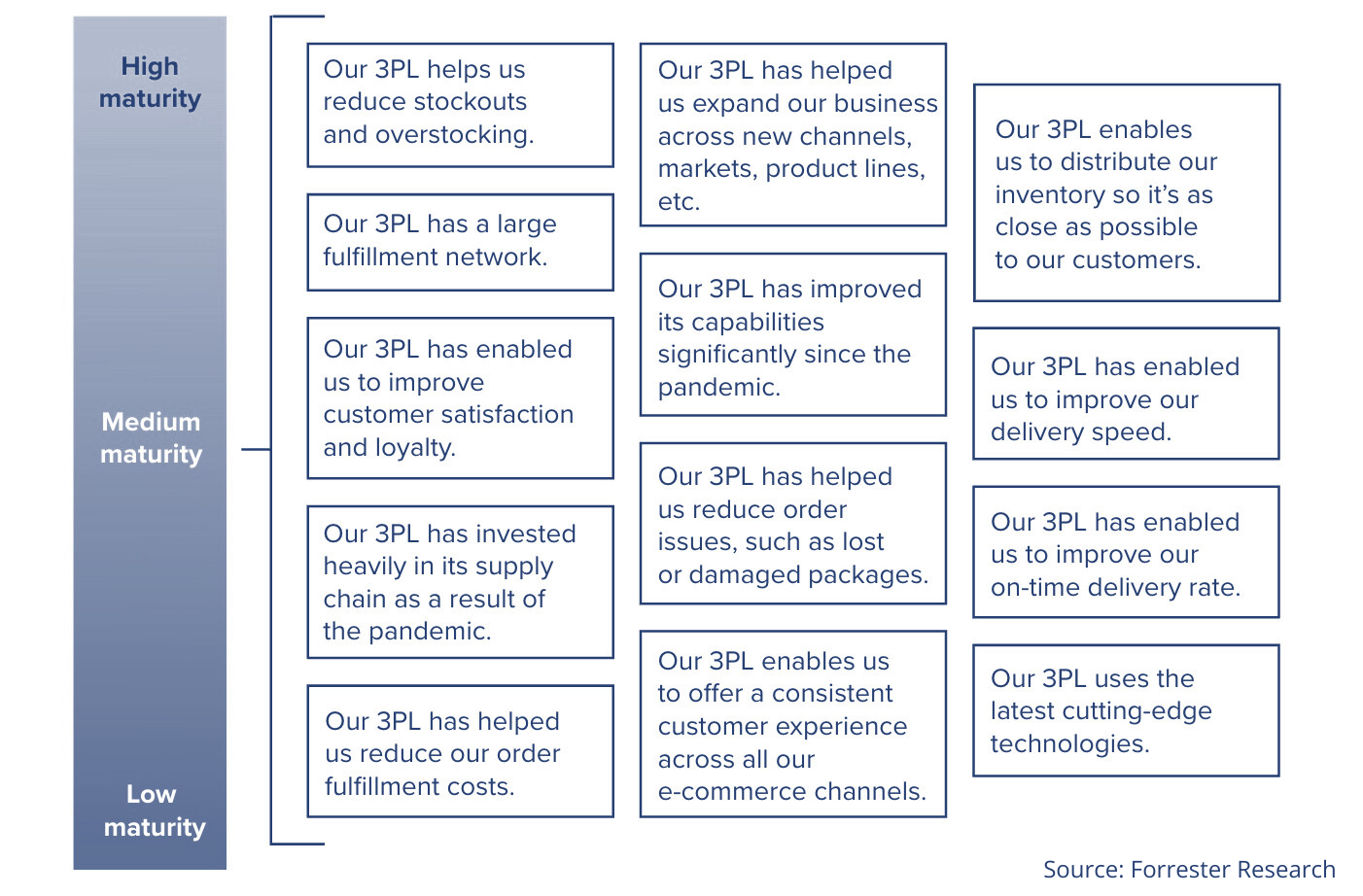Convert More Shoppers with Fast, Reliable Fulfillment
High Maturity 3PL Providers Dramatically Accelerate eCommerce Outcomes
eCommerce organizations separate growth strategy from fulfillment performance at their peril. Traditionally, marketing leaders focus on revenue growth and retention. Supply chain leaders, instead, focus on operational metrics and cutting costs.
The next generation of marketing leaders understands they must be concerned with their fulfillment approach, due to its impact on their customer’s experience.
RMW Commerce has previously written about mid-market supply chain offerings in its foundational research on Fulfillment Accelerators. In the past month, Forrester has introduced new research, commissioned by Amazon, that sheds new light on the space. This new research discusses the impact that fulfillment can have on both customer outcomes and bottom-line expansion.
There are two critical insights from the Forrester Report:
First, it matters to whom you outsource.
From the size of the Third-Party Logistics (3PL) provider’s fulfillment network, to the use of cutting-edge technology, maturity affects performance. As part of the report, Forrester introduced a new maturity model that allows shippers to rate third-party logistics providers based on a set of criteria like network size, capabilities, and needs.
Second, great results come from partnering with a high maturity provider.
Improved business outcomes include higher conversion rates, enhanced customer lifetime value, and reduced fulfillment costs. Examples include: 32% reduction in average fulfillment cost per order, 35% on-time delivery rate improvement, and 35% improvement in pick-to-ship cycle time.
This article attempts to unpack these two key insights so that brands can better navigate their road to fulfillment improvement.
The Benefits of Effective Fulfillment
Even decades after Amazon has consistently proven that fulfillment excellence is one of the most important elements to online retail, many CEOs still haven’t gotten the memo. The chasm between “my customers don’t seem to complain” and “my supply chain is a strategic asset” is quite wide.
The traditional Amazon Flywheel image explains clearly how Amazon views its customer experience, of which fulfillment performance is a centerpiece.
If you ship faster, customers buy more. RMW Commerce believes that this purchase frequency is driven by two factors both fast shipping and reliability combined. Forrester’s report provides the data to support these claims:
85% of retailers feel that better fulfillment practices give them a significant competitive advantage over their competitors.
79% say that poor fulfillment can cause a loss of customer trust and loyalty
78% of retailers state that poor fulfillment will result in a direct loss of eCommerce revenue.
Forrester indicates that 82% of e-commerce leaders found that offering faster delivery speeds increased shopper conversion. How fast? Forrester provides data here as well: 5 years ago, customers expected 5.7 days for delivery on average. In 2024, customers expect between 2 and 3 days. By 2029? Same day or next-day will be everyone’s standard.
Why Outsource Fulfillment to a 3PL?
Having established that effective fulfillment can be a strategic asset for customer acquisition and loyalty, the question remains: How to do it? There are only two fundamental choices.
Fulfill yourself. This requires metrics, facility and inventory placement, and operational excellence. Not to mention, continuous improvement to stay ahead of customer expectations.
Outsource to the right provider. This can seem just as daunting because it requires handing you inventory and customer experience over to a third-party: two things that brands usually hold very tightly in their grip.
In order to decide which of these is the right approach for you, RMW Commerce believes that the first question brands must answer is the following:
What Does Good Fulfillment Actually Look Like?
Lack of awareness is the first problem that brands must solve. The old adage “you cannot manage what you don’t measure” is especially true when trying to deliver great customer experiences through fast and reliable fulfillment.
Standing in the way of many brands is the “Devil You Know” fallacy — in other words, if there are mistakes to be made in providing a customer experience, at least they will be our mistakes, and not a third-party’s mistakes. Unfortunately, without proper metrics this just amounts to burying your hand in the sand because you still don’t know what good looks like.
Forrester’s data includes a number of stats, and how well retailers are tracking them. From the list, RMW Commerce feels that some of the biggest misses include:
Pick to ship cycle time (43%)
Order fill rate (42%)
Inventory accuracy rate (41%)
Inventory turnover rate (34%)
Out of stock rate (28%)
Key Recommendation. Before deciding to outsource or keep things in-house, get your data correct. Forrester reports that many brands, when they do measure properly, find their experience is sub-par. In fact, on average, only 86% of orders are delivered on time, and 63% of retailers say that at least 1 out of 10 of their orders are delivered late.
High Maturity Providers: What Good Looks Like
Now that we have established that outsourcing should at least be on your radar, the next question is: “To whom?” How to separate the wheat from the chaff? Let’s start with a definition of what good looks like from a delivery speed point of view: in short, the standard is 2 days at a minimum and moving quickly to next day, according to Forrester. Furthermore, after outsourcing, many brands report moving from 3-5 day delivery speeds on average to 2 days or less.
Key Benefit: Improved Brand Strength and Increased Conversion
The payoff for finding the right provider is clear, improving your brand position and increasing sell-through. In particular, within Forrester’s data, 93% of those working with high-maturity 3PL providers say that offering faster delivery speeds has enabled them to increase shopper conversion by more than 25%. RMW Commerce believes strongly that this increase in conversion is primarily due to the combination of speed and reliability, as found by Amazon all those years ago. Consumers remember a great experience.
Moving Forward
Having established that fulfillment should be a strategic marketing asset, the road forward is straightforward for many brands:
Establish your current fulfillment KPI benchmarks.
Compare yourself to the best.
Model the marketing uplift from improved fulfillment.
Establish the capabilities you need to measure potential providers.
Conduct a thorough search for a high-maturity provider.
Here, Forrester’s model can also be helpful for brands. Several key capabilities tend to separate the top providers from the bottom, according to their data:
The urgency of this approach cannot be overstated for an organization looking to stand out. Look beyond the amount and efficiency of your advertising spend for growth. Leading organizations must prioritize continuous fulfillment improvement to gain meaningful share.
To find out more, Download the Forrester Study here.



